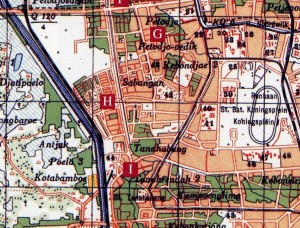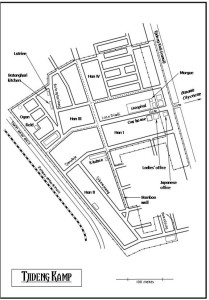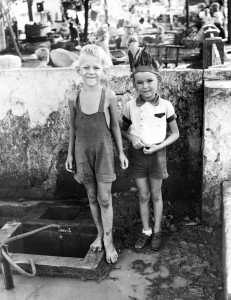Tjideng Prison Camp
Tjideng Prison Camp.

The Tjideng Prison Camp for women and children was initially declared a “protected area” as of August 1942. It was located on the western edge of Batavia todays’ Jakarta) between the Tjideng (Cideng) canal on the east and the railway line to the west. On the accompanying map its location is marked by the letter “H”. The large open area to the east is now called Merdeka square, the centre of Jakarta.
Dwellings varied from modern brick bungalows with pan tiled roofs to huts made in traditional Javanese style from Bamboo. The prewar population was a mixture of European and Asian and could be described as lower middle class. In order to accommodate the Europeans all those with Asian blood were evicted.
Tjideng Geography
The land here is a flat lying, poorly drained and previously had been used for rice cultivation. Beyond the railway line to the west rice paddies were still in production.
The main artery of the Tjideng Prison Camp was then called Laan Trivelli, (today’s Jalan Tanah Abang 2).
On the sketch map re indicated some of the key features described in the book “Tjideng Reunion“. During the early days of the occupation , what had then been designated euphemistically as a “protected area” extended further to the south and to the east, closer to the city centre where the houses were of more generous sizes and probably occupied by a more well to-do , predominantly European population.
By the time, we arrived in May 1945, the population of the camp had increased by a factor of four and the surface area had been reduced by fifty percent while a second bamboo and barbed wire barrier had effectively turned the camp into a high security prison with watch towers manned by armed guards.
Tjideng camp life
A good account of the early days in Tjideng ( October 1942-4 July,1943) can be found in Elly Campioni’s memoire (in Dutch). her book also describes a short period in this camp between 29 August 1944 and 8 September 1944. This second period overlaps the complementary account in my book, Tjideng Reunion. For the period April 1944- July 1945 this camp , along with several others in the Jakarta area, were under the command of the notorious, mentally unstable, Captain Sonei Kenichi, who imposed a regime of terror and starvation and who bore a great responsibility of the disastrous hygienic conditions. So foul smelling was the camp that the guards were reluctant to enter. The camp gate was the preferred location for brutal punishment. Sonei was convicted as a class B war criminal and executed in 1946.
The following image gives some indication of the hygienic conditions. By chance the picture was taken of me, presumably because the photographer, a man called Ripassa (Eurasian and therefore left at liberty) , undertook to investigate the mysterious camp shortly after the Japanese capitulation and took a picture of the first children he encountered

I am standing in our front yard , close by the road , and on the concrete box where the drinking water came in from the water main supply line under the street. The water pressure was too low to permit the faucets inside our house to function and water could only be obtained at this spot with great patience at night time when the needs of Jakarta were less pressing. Our house harboured one hundred and ten women and children. The prewar septic field system in use by these homes had long ceased to absorb the sewage needs and a ditch by the side of the road served as an open sewer.
Leave a Reply